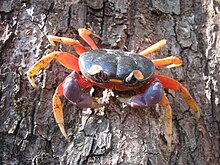Gecarcinus
Appearance
| Gecarcinus | |
|---|---|

| |
| Gecarcinus quadratus | |
| Scientific classification | |
| Domain: | Eukaryota |
| Kingdom: | Animalia |
| Phylum: | Arthropoda |
| Class: | Malacostraca |
| Order: | Decapoda |
| Suborder: | Pleocyemata |
| Infraorder: | Brachyura |
| Family: | Gecarcinidae |
| Genus: | Gecarcinus Leach, 1814 |
| Type species | |
| Cancer ruricola | |
Gecarcinus is the type genus of the land crab family Gecarcinidae. They are found in warmer coastal regions of the Americas, including islands in the Caribbean. Four species from oceanic islands were formerly included in Gecarcinus as the subgenus Johngarthia, but are now treated as a separate genus, Johngarthia.[1] While all members of this genus are largely terrestrial, they have to return to the ocean to breed (the larvae are released into the sea). They are often colourful, with reddish, orange, purple, yellowish, whitish, or blackish being the dominating hues. This has resulted in some species, notably G. quadratus and G. lateralis, gaining a level of popularity in the pet trade.
Species
[edit]| Image | Name | Common name | Distribution |
|---|---|---|---|
 |
Gecarcinus lateralis (Fréminville, 1835) | black back land crab, Bermuda land crab, red land crab | South Padre Island, Texas, south to Macuto, Venezuela |
 |
Gecarcinus quadratus (Saussure, 1853) | red land crab, whitespot crab, halloween crab, moon crab, halloween moon crab, mouthless crab or harlequin land crab | Pacific coast from Mexico south to Panama |
 |
Gecarcinus ruricola (Linnaeus, 1758) | purple land crab, black land crab, red land crab, and zombie crab | Cuba and the Bahamas in the west through the Antilles to Barbados in the east |
 |
Gecarcinus nobilii (Perger & Wall, 2014) | red land crab, ghostly moon crab, colombian land crab | Pacific coast from Colombia to Peru |
References
[edit]- ^ Peter K. L. Ng; Danièle Guinot & Peter J. F. Davie (2008). "Systema Brachyurorum: Part I. An annotated checklist of extant Brachyuran crabs of the world" (PDF). Raffles Bulletin of Zoology. 17: 1–286. Archived from the original (PDF) on 2011-06-06.
Further reading
[edit]- Bright, D.B.; Hogue, C.L. (1972). "A synopsis of burrowing land crabs of the world and list of their arthropod symbionts and burrow associates". Contributions in Science. 220: 1–58. doi:10.5962/p.241205. S2CID 92490593.
- Ng, P.K.L.; Guinot, D. (2001). "On the land crabs of the genus Discoplax A. Milne-Edwards, 1867 (Crustacea: Decapoda: Brachyura: Gecarcinidae), with description of a new cavernicolous species from the Philippines" (PDF). Raffles Bulletin of Zoology. 49 (2): 311–338.
- Türkay, M. (1970). "Die Gercarcinidae Amerikas. Mit einem Anhang uber Ucides Rathbun (Crustacea: Decapoda)" (PDF). Senckenbergiana Biologica (in German). 51 (5/6): 333–354.
- Türkay, M. (1987). "Landkrabben" (PDF). Natur und Museum (in German). 117 (5): 143–150.
- Perger, R.; Wall, A. (2014). "The description of a new species of the Neotropical land crab genus Gecarcinus Leach, 1814 (Crustacea, Decapoda, Brachyura, Gecarcinidae)". ZooKeys (435): 93–109. Bibcode:2014ZooK..435...93P. doi:10.3897/zookeys.435.7271. PMC 4141188. PMID 25152688.


